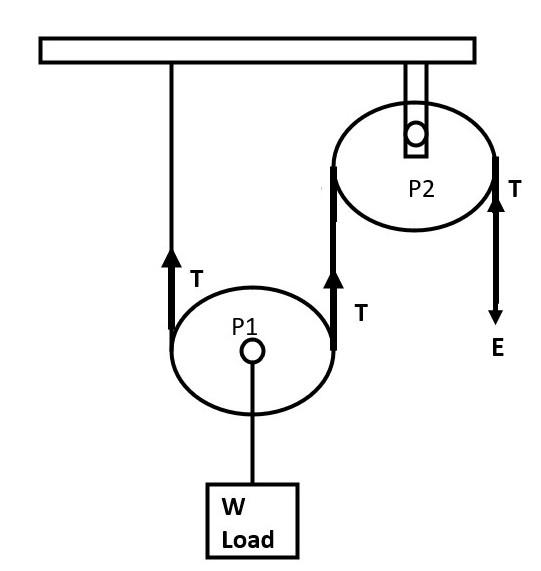
A movable pulley is used as:
a) force multiplier
b) speed multiplier
c) device to change the direction of effort
d) all the above
Answer
437.1k+ views
Hint: A movable pulley is attached with the string and a fixed pulley; it can move when load is attached to it. After attaining equilibrium, the whole system attains a stable state and after balancing the force, we will get a relation between force and load.
Complete answer:
Consider a movable pulley P1 and a fixed pulley P2 used to lift up load W.

P2 is fixed pulley, tension along pulley P2 is equal to the E.
Total upward tension in pulley $P1 = 2T$
Total downward force in pulley $P1 = W$
At equilibrium, net force is zero.
$\textit{upward force} = \textit{downward force}$
$2T = W$
$T = \dfrac{W}{2}$
The movable pulley decreases the force required to pull a load by a multiple of $2 \times $ movable pulleys number. The force will be half of that weight lifted in a movable pulley as the massless pulley forces should balance. So, a Movable pulley is used as a force multiplier.
Option (a) is correct.
Additional Information:
A movable pulley has additional numbers of strings used to raise mechanical advantage, and that advantage is load can elevate by implementing a force equivalent to half the load. A movable pulley is supported by two parts of the exact string and produces mechanical support.
Note:
The mechanical advantage is the fraction of the load to the tension of the system. The mechanical advantage of a pulley system balances the rope's tension force with the force of gravity on the load. The frictionless and massless pulleys do not disperse energy and change the direction of a rope that does not stretch. A force balance on the body of load W and n supporting sections of a rope with tension T gives:
$nT – W = 0$
$n = \dfrac{W}{T}$
Thus, the system's mechanical advantage is equal to the number of rope sections carrying the load.
Complete answer:
Consider a movable pulley P1 and a fixed pulley P2 used to lift up load W.

P2 is fixed pulley, tension along pulley P2 is equal to the E.
Total upward tension in pulley $P1 = 2T$
Total downward force in pulley $P1 = W$
At equilibrium, net force is zero.
$\textit{upward force} = \textit{downward force}$
$2T = W$
$T = \dfrac{W}{2}$
The movable pulley decreases the force required to pull a load by a multiple of $2 \times $ movable pulleys number. The force will be half of that weight lifted in a movable pulley as the massless pulley forces should balance. So, a Movable pulley is used as a force multiplier.
Option (a) is correct.
Additional Information:
A movable pulley has additional numbers of strings used to raise mechanical advantage, and that advantage is load can elevate by implementing a force equivalent to half the load. A movable pulley is supported by two parts of the exact string and produces mechanical support.
Note:
The mechanical advantage is the fraction of the load to the tension of the system. The mechanical advantage of a pulley system balances the rope's tension force with the force of gravity on the load. The frictionless and massless pulleys do not disperse energy and change the direction of a rope that does not stretch. A force balance on the body of load W and n supporting sections of a rope with tension T gives:
$nT – W = 0$
$n = \dfrac{W}{T}$
Thus, the system's mechanical advantage is equal to the number of rope sections carrying the load.
Recently Updated Pages
Master Class 10 Computer Science: Engaging Questions & Answers for Success

The correct geometry and hybridization for XeF4 are class 11 chemistry CBSE

Water softening by Clarks process uses ACalcium bicarbonate class 11 chemistry CBSE

With reference to graphite and diamond which of the class 11 chemistry CBSE

A certain household has consumed 250 units of energy class 11 physics CBSE

The lightest metal known is A beryllium B lithium C class 11 chemistry CBSE

Trending doubts
Is Cellular respiration an Oxidation or Reduction class 11 chemistry CBSE

In electron dot structure the valence shell electrons class 11 chemistry CBSE

What is the Pitti Island famous for ABird Sanctuary class 11 social science CBSE

State the laws of reflection of light

One Metric ton is equal to kg A 10000 B 1000 C 100 class 11 physics CBSE

Difference Between Prokaryotic Cells and Eukaryotic Cells




